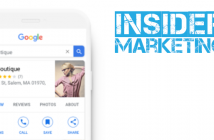› Proofread everything. This may seem simple, but it can be one of the easiest mistakes to make, and one of the biggest killers of credibility. Even our in-house copywriting team always has another set of eyes review its work, just to make sure nothing was overlooked.
Your brand is more than just logos and pictures—everything that goes into your product, from your staff, to your location, to your course itself, all contribute to brand identity.
MARKETING TOOLS
When we coach clients on marketing plans, most people want to cut straight to this step. The challenge, of course, is having an awareness of the target market, as that will inform the tools that are used. Here are a few of our favorites tools and the best places to use them.
1. Websites are probably the most common marketing tool in any industry today, and costs and effectiveness can vary greatly. Unless you have someone internal with stellar coding and SEO experience, we highly recommend working with an experienced web development firm. In addition to the branding recommendations, make sure you consider the following:
› Load time. It takes less than a second to lose a website visitor if your page does not load. A solution can be keeping a simple home page, free of video or high-resolution graphics.
› Mobile optimization. If you are in a tourist area, most of your users will find you through their mobile devices, not their laptops. Make sure all of the pertinent information, including contact data, is easily accessible from your mobile site. Remember, certain Apple devices don’t play well with certain Adobe products (namely Flash), so be sure that is not an issue for your developer.
› Travel sites. While we aren’t including this as its own specific tool, as much of it is user-generated content, client review sites like TripAdvisor (geared primarily toward tourist markets) and Yelp (geared primarily toward local markets) can be the make-or-break for an attraction. This is a great way to encourage more reviews and promote the ones that you have. (See “Hits and Misses.”)
› Call to action. Every page should remind visitors to come to your course. The call to action should include contact information, but also serve as a proactive reminder: “Click here to reserve your spot now!” or “Call us to learn more about our different courses.”
2. Billboards are great for high-density tourism markets where people are likely to be driving through. Examples include national park areas and major interstates in touristy regions (Colorado’s I-70, California’s I-5 and 101, and I-40 in Tennessee are all great examples). We recommend placing billboards within a 50-mile radius of aerial parks in either direction along major interstates.
The most important consideration to remember is that visitors will only see you for a few seconds as they pass, so make sure that your contact information is visible and easy to remember. This is why those 888 numbers with integrated words were invented.
This is typically no small investment, though billboard costs vary based on region and size. You may want to reconsider this investment if:
› You cater primarily to a local market;
› Your attraction is located more than 50 miles from a major interstate;
› You are located in an area where people don’t typically drive (i.e., a ski resort or an amusement park destination where people fly in and shuttle directly from the airport);
› You already have had success in other, lower-cost marketing tools.






